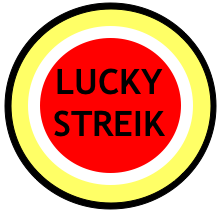Student strike 1997
The 1997 student strike was the largest student protest movement since the 1968 movement . The wave of protests among students in Germany from Gießen and in particular from Justus Liebig University against the undersupply of universities broke out in autumn 1997 . It reached its peak in December with nationwide student strikes, some of which lasted several weeks. In many cities, projects were launched and students were politicized. On November 27th, the largest nationwide demonstration took place in Bonn's Hofgarten, with around 40,000 participants, which attracted a great deal of attention in federal politics across all parties. Although a large number of German universities were involved in the protests and the goals of the students were also supported by politics and society, the wave of protests subsided at the beginning of spring 1998.
Lucky strike
The protests of the winter semester 1997/98 were under the motto Lucky Strike . This motto, which was graphically processed based on the similar sounding cigarette brand Lucky Strike , characterizes the guiding motto of the forms of protest. In contrast to the fundamental protests of the 1968 movement, the students were eager to find concrete solutions from the outset (“Seminar leader instead of Eurofighter ” was one of the slogans). Fundamental social change was not required. The forms of protest student strike, with the resulting high-profile presentations of the problem, were carried out in such a way that the decision-makers showed goodwill to the strikers.
Projects
A special feature of the protests was the activation and politicization of some of the students. As a rule, this politicization was aimed at the local conditions of the students. There were only minor protests across Germany. The demands of the students were not met nationwide. Nevertheless, there were a number of local changes and the creation of projects.
So z. B. in Göttingen the student union newspaper Die Banalen der Physik . In addition, mostly local student lists were formed in the wake of the strike; in Bochum, for example, left-wing university groups joined forces during the protests to form a joint “Left List” that still exists today.
Attempts to organize
As a consequence of the demise of the wave of protests in the spring of 1998, a number of students started long-term attempts to organize. The establishment of the Federation of Education Syndicates in November 1998 caused a sensation when education syndicates founded in seven cities joined forces as a joint branch union and shortly afterwards joined FAU . The aim was to overcome the tradition of only sporadic protests in the student body and to do continuous work in the education sector within the framework of an organization. Presented by various media outlets as the “first nationwide student union”, their concept is actually based on the organization of teachers, learners and employees in the education sector across all status groups.
Internet
Although the protests were not uniform nationwide and only a few cross-university actions were planned, the strikers were well informed about the actions of fellow students at other university locations. For the first time, reports on the strike and local events were posted on websites, some of which were updated every minute.
Individual evidence
- ↑ Joachim Mohr: “ Anger grows constantly .” Der Spiegel 49/1997, p. 32.
literature
- Georg Brandt (Ed.): "Lucky Strike" - a fight for education: Giessen students report . Focus-Verlag, Giessen 1998, ISBN 3-88349-467-4
- Christoph Bieber and Eike Hebecker: Virtuoso protest in the data room: On the emergence of digital movement networks in the university strike ( Memento from April 28, 2005 in the Internet Archive ) . In: Telepolis , January 20, 1998, Heise Zeitschriften Verlag
- Susanne Schmidt and Marcus Hawel (eds.): On the benefit of criticism: perspectives of students and their protests . Offizin-Verlag, Hannover 1998, ISBN 3-930345-14-5
Web links
- Video documentation of a week of the student strike in December 1997 (focus on Wuppertal) , student thesis in communication design
